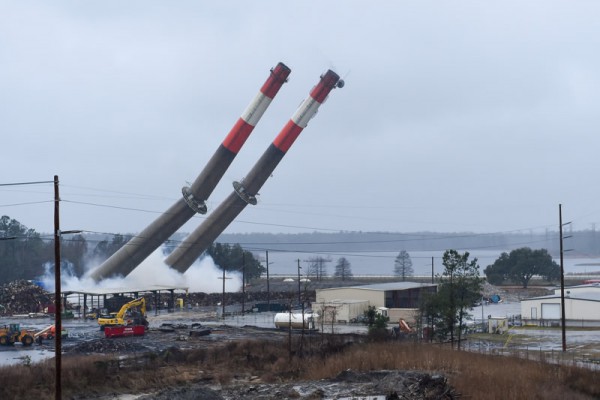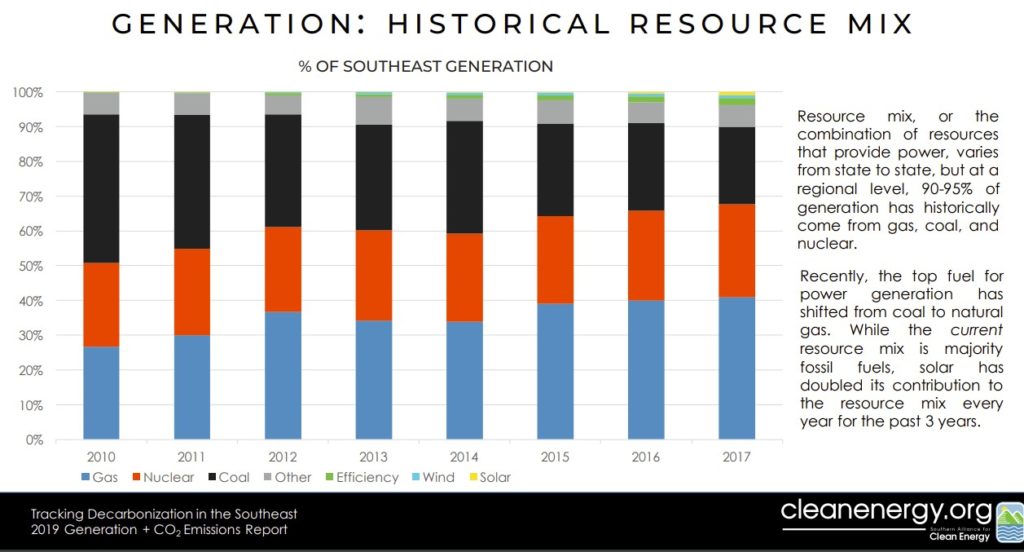
By Lindsay Street, Statehouse correspondent | The next 18 months could determine the future of carbon dioxide emissions in South Carolina, according to energy analyst Eddy Moore.
A new report by the Southern Alliance for Clean Energy found the Southeast U.S. has seen a 28 percent decrease in carbon dioxide emissions from the generation of electricity over the last decade. South Carolina has seen a 33 percent decrease among utility emissions. But it may not be enough to stave off global climate change.
Electricity production is the top emitter of carbon dioxide in the Southeast. Two looming decisions could allow South Carolina to decrease carbon emissions additionally, according to Moore, who is director of energy and climate programs at the Coastal Conservation League.

First is the decision over how much should solar farms receive for power they generate. In November, the state Public Service Commission will begin implementing parts of the S.C. Energy Freedom Act — the price to pay solar farms. And if solar farms are given a fair price for power, they will begin competing head-to-head with the remaining coal plants. As solar-power generation prices drop, Moore said they will begin to out-compete natural gas, too.
Then in 2020, state lawmakers will decide whether to privatize or restructure Santee Cooper, the state’s largest power generator. Moore said they need to consider carbon dioxide reductions as part of that decision.
“The question there is, is that going to be a largely natural gas-based plan or a largely solar and efficiency plan?” Moore said.
Cooling on coal
South Carolina emits more pounds of carbon dioxide per megawatt hour than the Southeastern average, according to the Southern Alliance for Clean Energy’s “Tracking Decarbonization in the Southeast.” Carbon dioxide, usually referred to as just “carbon,” is a leading greenhouse gas emitted by human activity and linked to climate change, according to the U.S. Environmental Protection Agency.
But the report had good news: carbon emissions for the state and region are already dropping — even without big legislative or regulatory action.
“This report shows we have already made progress, which is heartening,” Moore said.
There currently are five coal-fired plants between state-owned Santee Cooper and Dominion Energy South Carolina (formerly South Carolina Electric & Gas, SCE&G), which are among the top five carbon-emitting utilities in the Southeast. Three have closed in recent years, and one station has converted to dual-fire, meaning it can also run on natural gas.
Utilities throughout the Southeast are retiring coal-powered plants in favor of natural gas plants, which emit half the amount of carbon. The report found that nuclear-power generation remained steady, while there has been growth among renewable energy, especially solar.

In South Carolina, emissions from power generation have dropped from 59.5 million short tons (2,000 pounds) of carbon in 2010 to 39.8 million short tons in 2017. If utilities in the state continue business as usual, that number is expected to decrease further to 36.3 short tons.
In 2017, Santee Cooper emitted 14 million short tons of carbon dioxide. That figure is nearly half of what it emitted in 2010 (25.6 million short tons). The utility has retired two coal-fired plants and currently has two other coal-fired plants operating with no plans to close either, according to Santee Cooper Corporate Communications manager Mollie Gore.
“Santee Cooper has been steadily reducing our reliance on coal generation over the past decade, as we’ve added more renewables, maximized output at our own natural gas station and increased our purchase of off-system natural gas-fueled generation to take advantage of the low natural gas prices,” Gore said. “We’ve gone from a generation mix that was 77 percent coal in 2008 to one that was 46 percent coal last year.”
And that was during the utility’s bungled bet on nuclear, where it and SCE&G poured billions of dollars in a failed attempt to expand nuclear generation. The project was shuttered in 2017.
“The goals specifically to our generation included expanding the nuclear footprint and, of course, that hasn’t happened,” Gore said. The company does not have a specific goal set for the future. But that could change as lawmakers eye privatization or restructuring the utility, and the utility has a new CEO, Mark Bonsall. Bonsall formerly ran public utility Salt River Project in Arizona, which had emission-reduction targets.
In 2017, SCE&G emitted 13.1 million short tons of carbon dioxide — a slight decrease over its 2010 emissions of 13.8 million short tons. Also that same year, the utility shuttered one of its coal plants. Dominion South Carolina has no plans to close its three remaining coal plants in the state, according to Dominion Public Affairs Specialist Paul Fischer.
“We are doing our part by investing heavily in low- and no-carbon energy such as natural gas, additional solar resources and off-shore wind generation,” Fischer wrote in a statement to Statehouse Report. He also cited that the utility worked with lawmakers on the Energy Freedom Act, which directs the Public Service Commission to work with renewable energy farms and utilities.
Duke Energy Carolinas, which has the smallest footprint in South Carolina but covers most of North Carolina , emitted 30.3 million short tons regionally in 2017 — a 25 percent decrease over what it emitted in 2010 (40.5 million short tons). The utility’s parent company, Duke Energy, was spotlighted in the report for its commitment to reduce its 2005 carbon dioxide emissions by 40 percent before 2030.
But the report and its authors warned that the move to natural gas is not the ideal solution for decreasing greenhouse gas emissions.
“The process of drilling for and delivering gas to the region causes extremely high methane emissions, primarily due to leaks in the gas transmission system. This leakage is referred to as ‘fugitive emissions’ of methane, and many utility systems are beginning to track them due to aging gas pipelines and infrastructure,” the report said. Methane is another greenhouse gas linked to climate change.
Additionally, SACE Deputy Director of Regulator Policy John Wilson of Washington, D.C., said Thursday that, even with falling carbon emissions, the region is still “falling short of the goals that scientists are recommending to avoid the worst of the climate crisis.”
Moore said more needs to be done.
On the horizon
Imagine that prior to flipping a switch on in your house, you decided how that power would be generated. Would you choose coal? Natural gas? Solar?
One state lawmaker said he wants to make buying electricity akin to buying bread. Like choosing whole wheat, a customer could choose to buy power generated solely by solar.

S.C. Sen. Tom Davis, R-Beaufort, said the path toward making that decision is already in progress with the 2019 Energy Freedom Act.
“There is going to be more energy legislation next year. A first step to free and fair markets is a public awareness of which energy producers generate more of these emissions than others. That education role is critical so the public becomes aware,” Davis said.
Davis said he has one big objective in mind: abolishing territorial monopolies held by utilities. He said he’s working toward the incremental changes needed to achieve the goal, expecting it to take years. It took two sessions for the legislature to pass the Energy Freedom Act.
Moore said it is unlikely the state legislature will pass any carbon-reduction goals, but said the recently passed act and a move toward allowing customers to choose will help reduce emissions.
- Have a comment? Send to: feedback@statehousereport.com
















 We Can Do Better, South Carolina!
We Can Do Better, South Carolina!